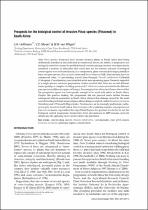 ResearchSpace
ResearchSpace
Prospects for the biological control of invasive Pinus species (Pinaceae) in South Africa
JavaScript is disabled for your browser. Some features of this site may not work without it.
- ResearchSpace
- →
- Research Publications/Outputs
- →
- Journal Articles
- →
- View Item
| dc.contributor.author |
Hoffmann, JH

|
|
| dc.contributor.author |
Moran, VC

|
|
| dc.contributor.author |
Van Wilgen, BW

|
|
| dc.date.accessioned | 2011-10-27T09:23:00Z | |
| dc.date.available | 2011-10-27T09:23:00Z | |
| dc.date.issued | 2011-09 | |
| dc.identifier.citation | Hoffmann, JH, Moran, VC and Van Wilgen, BW. 2011. Prospects for the biological control of invasive Pinus species (Pinaceae) in South Africa. African Entomology, Vol 19(2), pp 393-401 | en_US |
| dc.identifier.issn | 1021-3589 | |
| dc.identifier.uri | http://www.bioone.org/doi/abs/10.4001/003.019.0209 | |
| dc.identifier.uri | http://hdl.handle.net/10204/5259 | |
| dc.description | Copyright: 2011 Entomological Society of Southern Africa. Special permission to self archive this article was given by the publisher and copyright owner of the article "Entomological Society of Southern Africa". | en_US |
| dc.description.abstract | Nine Pinus species (Pinaceae) have become invasive plants in South Africa after being deliberately introduced and cultivated in commercial forests, for timber. A proposal to use biological control to contain the problem raised concerns among foresters who immediately identified a number of difficulties that could arise for the forestry industry if biological control agents were to be introduced. As a compromise, plans weremadeto target, initially at least, two pine species, Pinus pinaster Aiton and Pinus halepensis Mill., that currently have no commercial value. A cone-feeding weevil from Portugal, Pissodes validirostris Gyllenhal (Coleoptera: Curculionidae), was identified as the most promising agent. Formerly regarded as a single species, extensive preparatory studies revealed that there are several different forms (perhaps a complex of sibling species) of P. validirostris each associated with different pine species in different regions of Europe. Screening tests in arboreta in France showed that the prospective agent was host-specific enough to be used with safety in South Africa. Despite this positive finding, the programme did not proceed much further because subsequent trials in quarantine in South Africa showed that damage caused by the adult weevils feeding on leader shoots of pines allowed ingress of pitch canker, Fusarium circinatum Nirenberg and O’Donnell (Hypocreales: Nectriaceae), an increasingly problematic pathogen in pine forests in South Africa. However, given the escalating negative consequences of pine tree invasions, especially in the Cape Floral Region, the question of whether or not this biological control programme should have been discontinued in 2009 remains open for debate and the opposing views on the subject are presented. | en_US |
| dc.language.iso | en | en_US |
| dc.publisher | Entomological Society of Southern Africa | en_US |
| dc.relation.ispartofseries | Workflow request;7383 | |
| dc.subject | Cone feeding insects | en_US |
| dc.subject | Pissodes validirostris | en_US |
| dc.subject | Curculionidae | en_US |
| dc.subject | Pine pitch canke | en_US |
| dc.subject | Fusarium circinatum | en_US |
| dc.subject | Pathogen ingress | en_US |
| dc.subject | Conservation | en_US |
| dc.title | Prospects for the biological control of invasive Pinus species (Pinaceae) in South Africa | en_US |
| dc.type | Article | en_US |
| dc.identifier.apacitation | Hoffmann, J., Moran, V., & Van Wilgen, B. (2011). Prospects for the biological control of invasive Pinus species (Pinaceae) in South Africa. http://hdl.handle.net/10204/5259 | en_ZA |
| dc.identifier.chicagocitation | Hoffmann, JH, VC Moran, and BW Van Wilgen "Prospects for the biological control of invasive Pinus species (Pinaceae) in South Africa." (2011) http://hdl.handle.net/10204/5259 | en_ZA |
| dc.identifier.vancouvercitation | Hoffmann J, Moran V, Van Wilgen B. Prospects for the biological control of invasive Pinus species (Pinaceae) in South Africa. 2011; http://hdl.handle.net/10204/5259. | en_ZA |
| dc.identifier.ris | TY - Article AU - Hoffmann, JH AU - Moran, VC AU - Van Wilgen, BW AB - Nine Pinus species (Pinaceae) have become invasive plants in South Africa after being deliberately introduced and cultivated in commercial forests, for timber. A proposal to use biological control to contain the problem raised concerns among foresters who immediately identified a number of difficulties that could arise for the forestry industry if biological control agents were to be introduced. As a compromise, plans weremadeto target, initially at least, two pine species, Pinus pinaster Aiton and Pinus halepensis Mill., that currently have no commercial value. A cone-feeding weevil from Portugal, Pissodes validirostris Gyllenhal (Coleoptera: Curculionidae), was identified as the most promising agent. Formerly regarded as a single species, extensive preparatory studies revealed that there are several different forms (perhaps a complex of sibling species) of P. validirostris each associated with different pine species in different regions of Europe. Screening tests in arboreta in France showed that the prospective agent was host-specific enough to be used with safety in South Africa. Despite this positive finding, the programme did not proceed much further because subsequent trials in quarantine in South Africa showed that damage caused by the adult weevils feeding on leader shoots of pines allowed ingress of pitch canker, Fusarium circinatum Nirenberg and O’Donnell (Hypocreales: Nectriaceae), an increasingly problematic pathogen in pine forests in South Africa. However, given the escalating negative consequences of pine tree invasions, especially in the Cape Floral Region, the question of whether or not this biological control programme should have been discontinued in 2009 remains open for debate and the opposing views on the subject are presented. DA - 2011-09 DB - ResearchSpace DP - CSIR KW - Cone feeding insects KW - Pissodes validirostris KW - Curculionidae KW - Pine pitch canke KW - Fusarium circinatum KW - Pathogen ingress KW - Conservation LK - https://researchspace.csir.co.za PY - 2011 SM - 1021-3589 T1 - Prospects for the biological control of invasive Pinus species (Pinaceae) in South Africa TI - Prospects for the biological control of invasive Pinus species (Pinaceae) in South Africa UR - http://hdl.handle.net/10204/5259 ER - | en_ZA |





